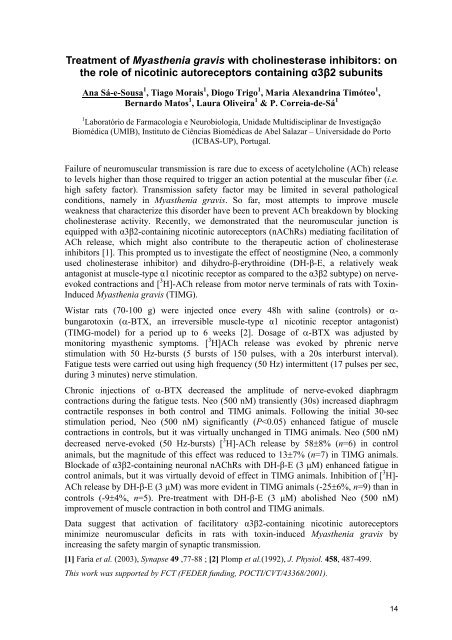IJUP08 - Universidade do Porto
IJUP08 - Universidade do Porto
IJUP08 - Universidade do Porto
- TAGS
- universidade
- porto
- ijup.up.pt
Create successful ePaper yourself
Turn your PDF publications into a flip-book with our unique Google optimized e-Paper software.
Treatment of Myasthenia gravis with cholinesterase inhibitors: on<br />
the role of nicotinic autoreceptors containing α3β2 subunits<br />
Ana Sá-e-Sousa 1 , Tiago Morais 1 , Diogo Trigo 1 , Maria Alexandrina Timóteo 1 ,<br />
Bernar<strong>do</strong> Matos 1 , Laura Oliveira 1 & P. Correia-de-Sá 1<br />
1 Laboratório de Farmacologia e Neurobiologia, Unidade Multidisciplinar de Investigação<br />
Biomédica (UMIB), Instituto de Ciências Biomédicas de Abel Salazar – <strong>Universidade</strong> <strong>do</strong> <strong>Porto</strong><br />
(ICBAS-UP), Portugal.<br />
Failure of neuromuscular transmission is rare due to excess of acetylcholine (ACh) release<br />
to levels higher than those required to trigger an action potential at the muscular fiber (i.e.<br />
high safety factor). Transmission safety factor may be limited in several pathological<br />
conditions, namely in Myasthenia gravis. So far, most attempts to improve muscle<br />
weakness that characterize this disorder have been to prevent ACh break<strong>do</strong>wn by blocking<br />
cholinesterase activity. Recently, we demonstrated that the neuromuscular junction is<br />
equipped with α3β2-containing nicotinic autoreceptors (nAChRs) mediating facilitation of<br />
ACh release, which might also contribute to the therapeutic action of cholinesterase<br />
inhibitors [1]. This prompted us to investigate the effect of neostigmine (Neo, a commonly<br />
used cholinesterase inhibitor) and dihydro-β-erythroidine (DH-β-E, a relatively weak<br />
antagonist at muscle-type α1 nicotinic receptor as compared to the α3β2 subtype) on nerveevoked<br />
contractions and [ 3 H]-ACh release from motor nerve terminals of rats with Toxin-<br />
Induced Myasthenia gravis (TIMG).<br />
Wistar rats (70-100 g) were injected once every 48h with saline (controls) or αbungarotoxin<br />
(α-BTX, an irreversible muscle-type α1 nicotinic receptor antagonist)<br />
(TIMG-model) for a period up to 6 weeks [2]. Dosage of α-BTX was adjusted by<br />
monitoring myasthenic symptoms. [ 3 H]ACh release was evoked by phrenic nerve<br />
stimulation with 50 Hz-bursts (5 bursts of 150 pulses, with a 20s interburst interval).<br />
Fatigue tests were carried out using high frequency (50 Hz) intermittent (17 pulses per sec,<br />
during 3 minutes) nerve stimulation.<br />
Chronic injections of α-BTX decreased the amplitude of nerve-evoked diaphragm<br />
contractions during the fatigue tests. Neo (500 nM) transiently (30s) increased diaphragm<br />
contractile responses in both control and TIMG animals. Following the initial 30-sec<br />
stimulation period, Neo (500 nM) significantly (P










